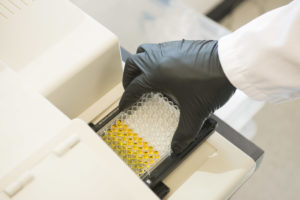Large molecule bioanalysis is a category of analytical chemistry in which a large molecule therapeutic is analyzed in a biological matrix. Commonly, the biological matrix is serum or plasma. Large molecule drug products (such peptides, proteins, monoclonal antibodies and antibody drug conjugates) have proven to be very effective at combating a variety of different disease indications. As more and more large molecule products are being developed, large molecule bioanalysis performed by CROs, such as PBL, has become increasingly more common. The common types of bioanalytical studies are: pharmacokinetic (PK) studies, pharmacodynamics (PD) studies, immunogenicity testing and biomarker assays.

Pharmacokinetic (PK) Large Molecule Bioanalysis
Preclinical and clinical studies will typically include pharmacokinetic (PK) bioanalysis of serum or plasma samples. Preclinical PK studies usually involve dosing animals or patients with the drug product and then blood samples are taken at various time points. Serum or plasma is isolated and sent to an analytical lab. At PBL, the in vivo portion of a PK study and analytical portion of the study takes place in the same facility, making PK studies much easier to conduct at PBL than other labs. The concentration of drug product in serum or plasma is measured using bioanalytical techniques. For large molecules, the methods for determining the concentration are usually ligand binding assays such as ELISA or MSD. In some cases, mass spectrophotometer instruments can be used for large molecule bioanalysis. From the raw data taken by the lab, Cmax (peak drug concentration), Tmax (time to reach Cmax), Cmin (the lowest concentration of the drug before the next dose is administered) and AUC (area under the curve, which is the integral of the concentration-time curve) can be determined using statistical software.
Toxicokinetic (TK) Large Molecule Bioanalysis
Pre-clinical Toxicokinetic (TK) studies have similarities with Pharmacokinetic (PK) studies, but have several key differences. First, toxicokinetic studies are performed at much higher doses which allows for toxic affects to be more apparent. For obvious reasons TK studies are only conducted in animals rather than humans. The objectives of TK and PK studies also differ. The end point of a TK study is to determine the pharmacokinetics of a compound at elevated toxicological doses in order to establish acceptable drug exposure. The objective of a PK study is to enhance drug efficacy by understanding clearance and the bioavailability of the drug within the biological system.
Pharmacodynamic (PD) Large Molecule Bioanalysis
Pharmacodynamic (PD) studies analyzes the affect that the drug has on the patient, both the biochemical affects and physiological affects. Pharmacodynamic large molecule bioanalysis helps give insight into the drugs mechanism of action, how the drug works on a biochemical level. These studies are crucial to the complete understanding of the therapeutic. For example, if the large molecule therapeutic is peptide inhibitor, a PD bioanalytical studies will investigate which molecules bind to the peptide, how the targets are inhibited, what molecular signaling pathway is affected and what the downstream affects are.
Immunogenicity Large Molecule Bioanalysis
Because large molecules are much bigger than small molecules, the chance of large molecule therapeutics causing an immune reaction is much greater. Regulatory authorities typically require immunogenicity testing during clinical trials in order to characterize the immune response against the therapeutic within a patient population. These studies are also called Anti-Drug Antibody Assays or ADA assays because the patients produce antibodies against the drug and the assay is designed to detect and characterize those antibodies. In cases when immunogenicity is detected, many regulators would like to see if any of the anti-drug antibodies produced by the patient are affecting the activity of the therapeutic. To do this a Nab assays, or neutralizing antibody assays, must be developed. Nab assays are most commonly cell based assays which are similar to the in vitro potency assay that was developed to ascertain the biological activity of the drug product.
Biomarker Discovery and Validation
A biomarker is a molecule or other measurable indicator which can be used to identify a disease state. For example, the BRCA2 gene is a biomarker for breast cancer. High blood pressure is a biomarker for hypertension and a small protein called NGAL is a molecular biomarker for acute kidney injury. Biomarker discovery is often a bioanalysis exercise. Once a biomarker is discovered it would need to be validated before it can be used for regulatory or clinical purposes. It is beneficial for pharmaceutical and biopharma companies to validate biomarkers within a clinical trial because validated biomarkers can be used as a clinically relevant endpoint or can be used to determine if a particular therapy will be effective for a particular patient. Typically, biomarker validation is similar to validation of analytical procedures – specificity, selectivity, accuracy, precision, robustness, reproducibility among other parameters must be shown.
Large Molecule Bioanalysis Guidance Documents
The ICH and FDA has provided several guidance documents to help standardize large molecule bioanalysis studies. Below are a list of these guidance documents.
FDA Guidance Documents
Bioanalytical Method Validation
ICH Guidance Documents
Preclinical Safety Evaluation of Biotechnology-Derived Pharmaceuticals S6(R1)
Validation of Analytical Procedures: Text and Methodology Q2(R1)
PBL Bioanalysis Pages
To learn more about large molecule bioanalysis please visit the following pages:
